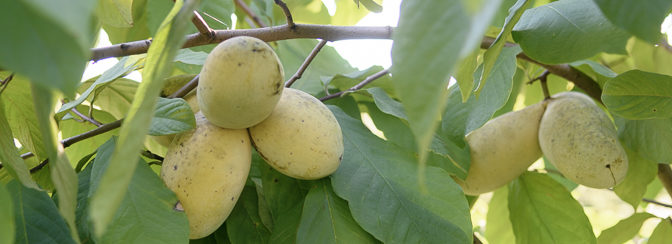Paw Paw videos
Growing Paw Paws
Pawpaw Production
The common pawpaw, Asimina triloba, is native to about the southeastern 1/3 of the United States. It is found in a wide range of habitats, from stream sides and river banks to steep mountainsides. The pawpaw is a natural understory tree, and will thrive and produce reasonably well under fairly heavy shade. That said, pawpaws will produce more fruit and larger-sized fruit when grown in full sun in a deep, fertile, moist but well-drained soil.
Pawpaws vary dramatically in fruit productivity, fruit size, seediness, and flavor. The best trees are heavy bearers of large-size, low-seeded fruit with excellent flavor. The best fruits range from potato to grapefruit size, have a custard-like texture, and a flavor like a cross between banana and mango. Some people report additional flavors in some varieties, including pineapple, citrus, coconut, melon, and vanilla.
Normally the best way to insure the production of high-quality fruit is to plant trees grafted to cultivars known to produce such fruit. Pawpaws are nearly unique among fruit trees in that it may make more sense for commercial growers to plant seedlings of superior trees crossed with other superior trees, as opposed to planting grafted trees. This is because the above-ground portion of a pawpaw tree is rather short-lived, about 15 years. Since it takes 5 years to so for a tree to start bearing, this means the average grafted tree will provide about 10 years of fruit production. The trunk then goes into decline, and dies. Meanwhile the root system starts sending up numerous shoots or “suckers”. In a grafted tree, these suckers will be genetically identical to the rootstock, not the grafted variety. If the rootstock is a wild pawpaw, the suckers will likely grow into trees bearing small crops of small-sized, seedy fruit of poor quality. In contrast, if you plant genetically superior seedlings, there is a high likelihood they will grow into trees bearing heavy crops of large-sized, superior fruits. The original trunks will still die in 15 years or so, but when they send up suckers, they will grow into trees bearing fruit just like the original.
Pawpaw trees have a rather delicate root system. They do not survive well when grown in a field and then dug up bare-root. Pawpaws should be grown in special pots that facilitate air-pruning of the root system, or else in special growing medium, such as a mix of peat and/or vermiculite.
Bare-root pawpaws should be planted in a hole deep and wide enough to accommodate the roots without crowding or bending the roots around the margins of the planting hole. Regardless of whether you are planting bare-root or potted pawpaws, the root crown – the point where root and trunk come together – should be planted right at the soil surface. No part of the trunk should be buried or allowed to settle below the soil surface.
Young, small pawpaw trees are sensitive to direct sunlight and can be stunted or even killed by it. Pawpaws planted in full sun should be protected by 2 foot tall tree shelters. The shelters provide just the right amount of shade while the tree is small, and by the time the pawpaw grows out the top it can then tolerate full sun.
Pawpaw trees are not generally self-fruitful. Genetically different pawpaw trees should be spaced close enough to provide cross-pollination. Trees should be spaced no closer than 10 feet or farther than 20 feet apart.
Deer don’t normally browse on pawpaws, but rabbits will often snip them off. Pawpaws should be protected from rabbits by 2 foot tall tree shelters. Mesh shelters can be used to protect pawpaws planted in shady sites.
Pawpaws can be planted in full shade without any protection from competing vegetation. On the other hand, pawpaws planted in full sun absolutely require effective weed control. Neither mowing, mulch, nor landscape fabric by themselves constitute effective weed control. A 3 foot square of landscape fabric around the base of each tree, topped with 2 – 3 inches of coarse wood chips, combined with keeping the vegetation mowed short right up to the edge of the fabric will provide excellent protection for young pawpaw trees.
With proper care, pawpaws trees should start bearing fruit at around 4 – 6 years of age, when they are 5 feet to 6 feet tall. You should remove any fruit that tries to set on trees under 5 feet in order to avoid permanently stunting the tree. At full production a pawpaw tree should bear between 15 and 50 pounds of fruit per year.
Pawpaw fruit can be marketed in a number of ways, including to restaurants, grocers, at Farmer’s Markets, or through mail-order/internet sales.
The easiest and most profitable way is to sell directly to customers who come to the farm and pick their own ripe fruit from the tree (“you-pick or PYO”). This marketing method eliminates the production costs of harvesting, handling/sorting, sanitation, refrigeration, packaging, and shipping. This is especially important as ripe pawpaws have a fairly short shelf life of only 1 – 3 days at room temperature and 1 – 2 weeks in refrigeration.
First-time PYO customers will have to be trained to judge fruit ripeness, otherwise they will pick unripe fruit with no chance of ripening off the tree. A pawpaw fruit is ripe enough to pick when it has softened to the point where a light squeeze with the fingertips will leave slight impressions that don’t spring back after you let go.
Tom Wahl
Red Fern Farm
13882 I Ave.
Wapello, Iowa 52653
www.redfernfarm.com
tom@redfernfarm.com

